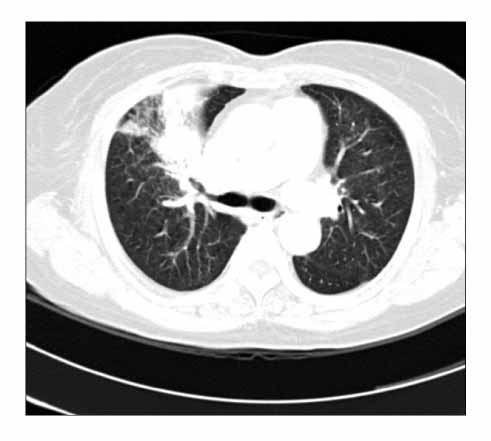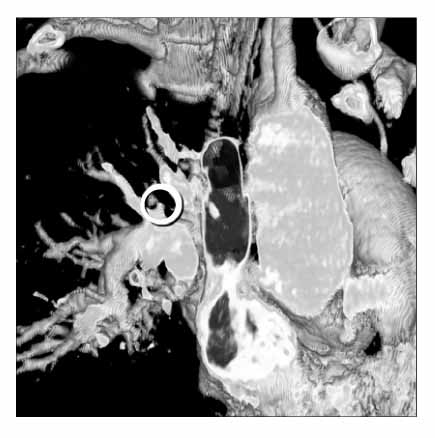Tuberc Respir Dis.
2007 Nov;63(5):430-434. 10.4046/trd.2007.63.5.430.
A Case of Pulmonary Artery-bronchial Fistula with Massive Hemoptysis due to Pulmonary Tuberculosis
- Affiliations
-
- 1Division of Pulmonary and Critical Care Medicine, University of Ulsan College of Medicine, Asan Medical Center, Seoul, Korea. sbhong@amc.seoul.kr
- KMID: 2050476
- DOI: http://doi.org/10.4046/trd.2007.63.5.430
Abstract
- Massive and untreated hemoptysis is associated with a >50% mortality rate. Since bleeding has a bronchial arterial origin in most patients, bronchial artery embolization (BAE) has become an accepted treatment in massive hemoptysis. The possibility of bleeding from pulmonary artery should be considered in patients in whom the bleeding focus cannot be found by Bronchial angiogram. Indeed, the bleeding occurs from a pulmonary artery in approximately 10% of patients with massive hemoptysis. The most common causes of bleeding from the pulmonary artery are pulmonary artery rupture associated with a Swan-Ganz catheter, infectious diseases and vasculitis. We report a rare case of a fistula between the right upper lobar pulmonary artery and the right upper lobar bronchus in a 71-year-old woman who presented with massive hemoptysis.
MeSH Terms
Figure
Reference
-
1. Hirshberg B, Biran I, Glazer M, Kramer MR. Hemoptysis: etiology, evaluation, and outcome in a tertiary referral hospital. Chest. 1997. 112:440–444.2. Thompson AB, Teschler H, Rennard SI. Pathogenesis, evaluation, and therapy for massive hemoptysis. Clin Chest Med. 1992. 13:69–82.3. Chun GM, Ellestad MH. Perforation of the pulmonary artery by a Swan-Ganz catheter. N Engl J Med. 1971. 284:1041–1042.4. Resano FG, Kapetanakis EI, Hill PC, Haile E, Corso PJ. Clinical outcomes of low-risk patients undergoing beating-heart surgery with or without pulmonary artery catheterization. J Cardiothorac Vasc Anesth. 2006. 20:300–306.5. Bidwell JL, Pachner RW. Hemoptysis: diagnosis and management. Am Fam Physician. 2005. 72:1253–1260.6. Kearney TJ, Shabot MM. Pulmonary artery rupture associated with the Swan-Ganz catheter. Chest. 1995. 108:1349–1352.7. Hwang SY, Chung JH, Park MS, Kim HJ, Hahn CH, Moon JW, et al. A case of aortobronchial fistula with massive hemoptysis after aortic stent graft. Tuberc Respir Dis. 2004. 56:405–410.8. Stoller JK, Picker LJ, Weiss ST, Thurer RL, Kasdon EJ. Pulmonary artery-bronchial fistula complicating chronic lymphocytic leukemia. Chest. 1984. 86:134–135.9. Davison BD, Ring DH, Bueno R, Jaklitsch MT. Endovascular stent-graft repair of a pulmonary artery- bronchial fistula. J Vasc Interv Radiol. 2003. 14:929–932.10. Conlan AA, Hurwitz SS, Krige L, Nicolaou N, Pool R. Massive hemoptysis: review of 123 cases. J Thorac Cardiovasc Surg. 1983. 85:120–124.11. Kessler R, Massard G, Warter A, Wihlm JM, Weitzenblum E. Bronchial-pulmonary artery fistula after unilateral lung transplantation: a case report. J Heart Lung Transplant. 1997. 16:674–677.12. Ruffini E, Oliaro A, Mancuso M, Cavallo A, Filosso P, Molinatti M, et al. Successful management of hemorrhage from the pulmonary artery stump after lobectomy for bronchogenic carcinoma. J Cardiovasc Surg (Torino). 1994. 35:257–259.13. Rubin SA, Puckett RP. Pulmonary artery-bronchial fistula: a new complication of Swan-Ganz catheterization. Chest. 1979. 75:515–516.14. Urschel JD. Delayed massive hemoptysis after expandable bronchial stent placement. J Laparoendosc Adv Surg Tech A. 1999. 9:155–158.15. Miyata T, Ohara N, Shigematsu H, Konishi T, Yamaguchi H, Kazama S, et al. Endovascular stent graft repair of aortopulmonary fistula. J Vasc Surg. 1999. 29:557–560.16. Jougon J, Ballester M, Delcambre F, Mac Bride T, Valat P, Gomez F, et al. Massive hemoptysis: what place for medical and surgical treatment. Eur J Cardiothorac Surg. 2002. 22:345–351.17. Oh JY, Lee SW, Kang YA, Yoon YS, Yoo CG, Kim YW, et al. Bronchial artery embolization in patients with hemoptysis: outcome and predictors of success. Kor J Med. 2005. 68:400–406.18. Swanson KL, Johnson CM, Prakash UB, McKusick MA, Andrews JC, Stanson AW. Bronchial artery embolization: experience with 54 patients. Chest. 2002. 121:789–795.19. Erkan F, Gul A, Tasali E. Pulmonary manifestations of Behcet's disease. Thorax. 2001. 56:572–578.20. Sanyika C, Corr P, Royston D, Blyth DF. Pulmonary angiography and embolization for severe hemoptysis due to cavitary pulmonary tuberculosis. Cardiovasc Intervent Radiol. 1999. 22:457–460.
- Full Text Links
- Actions
-
Cited
- CITED
-
- Close
- Share
- Similar articles
-
- Coronary to Bronchial Artery Fistula Causing Massive Hemoptysis in Patients with Longstanding Pulmonary Tuberculosis
- Bronchial artery embolization: clinical analysis of 129 cases
- A Case of Bronchial Artery Aneurysm in Cavitary Pulmonary Tuberculosis
- Successful Embolization in the Patient with Hemoptysis Due to Right Inferior Phrenic Artery-pulmonary Artery Anastomosis and Pseudoaneurysm
- A Case of Bronchial Artery Aneurysm Presenting with Massive Hemoptysis





